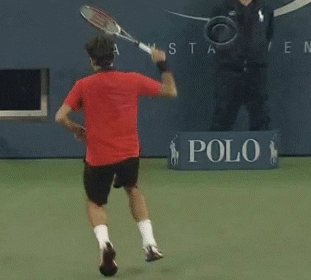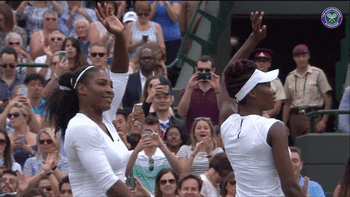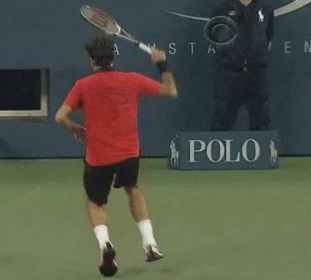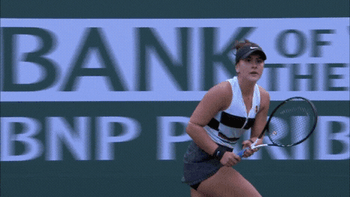
Game
Tennis is played in a game, set, match format. First is the game. Instead of a score going 1, 2, 3, 4; a game is scored 0, 15, 30, 40. Players have to win a game by at least two points, meaning if a game is tied 40-40, the next point scored will be “advantage” and, if that same player scores again, they’ve won the game. Wacky, we know!
Set
Next up is the set. A set is made up of a certain number of games. In grand slams, matches are best two out of three sets for women, and three out of five sets for men. In most other tournaments, it’s best two of three sets for both. To win a set, you have to be the first player to win six games and you also have to win by two. If you don’t win by two, it goes into a seventh game tie break.
Match
The match is the one worth all the marbles. To win a match, you have to win the majority of the sets. For example, when you see that Player A beat Player B in 6–2, 4–6, 6–2 it means they won six games in the first set, four games in the second (and lost that set) and then six games in the third set to win the match.
Singles
One-on-one action. Bring it on. A singles court does not include "doubles alley" — a thin rectangular strip on the edge of tennis court.
Doubles
Two players on each side of the court face off against each other. Normally one teammate is in charge of the frontcourt (closest to the net) and one teammate is in charge of the backcourt (closest to the baseline at the back). The court’s boundaries are also larger as it includes the "doubles alley" (see above) than in singles to allow more room for the two players.
Serve
Is used to start a point. Players toss the ball high up in the air and try to overhand hit it at the highest point of the toss so they can get as much force behind it as possible. The ball must go over the net and onto the opposite side of the court. Then the other player tries to return it.
If the ball goes out of bounds (called a fault) or hits the net (called a let), that player gets a redo. But you’re only allowed two tries or you lose a point! The first serve of a game is decided with a coin toss, and then the serve alternates for every game.
Fault
The server doesn’t get their serve in the service box (serves must land in the box drawn on the court opposite from the server) or their foot moves beyond the baseline. That’s a no-no.
Double fault
The server doesn’t get their serve in twice. Womp womp. Opponent wins the point.
Ace
A serve that the opponent simply cannot even touch because of it’s sheer speed or excellent position. Stop — can’t touch this.
Rally
A sequence of back and forth shots across the net. The rally ends when the ball is hit into the net or out.
No mans' land
The area between the service line and base line. It’s not a great place to chill because the ball is going to bounce in at your feet and not give you enough space to return it.
Doubles alley
The two strips on the far left and right of the court that is only counted as in if you’re playing doubles. In singles, the court is smaller.
Challenge
When the ref calls it out/in but you’re like “um, that most certainly was in/out.” Each player gets three challenges per set.
Forehand
Hitting the ball with your dominant hand on your dominant side.

Backhand
Hitting the ball with your dominant hand (or two hands!) on your non-dominant side. Similar to backhanded compliments, this type of stroke can be sneaky AF.
Love
Love stands for zero. Pretty depressing take on love, no?
Deuce
Deuce occurs when it’s tied 40–40 and you have to play additional points because, again, you have to win by two!
Advantage
When it’s 40–40, and then you win the next point, it’s called “advantage” because you only have to win one more point to win the game. If you have advantage and your opponent wins the next point, it goes back to 40-40. The suspense!
Breakpoint
In general, the person who is serving wins the game because having a serve is an advantage to start the rally. Breaking someone means that you win the game, set or match when your opponent is serving. A breakpoint is the last point of the game, set or match when you can win by breaking your opponents serve.
Unforced error
Sometimes you win a point because you did something right (high five!), but sometimes you win a point because your opponent does something wrong. This is called an unforced error. It normally consists of hitting the ball into the net, or our personal fave, a swing, and a miss.
Grand Slam
Grand Slam tournaments, also known as majors, refers to the four biggest tennis tournaments of the year. They are the Australian Open, the French Open (aka Roland-Garros), Wimbledon and the U.S. Open.
Fun fact: Serena Williams has 23 (!!!) singles Grand Slam titles. One more, and she'll tie Margaret Court for the most all-time. Just another level up on her GOAT status
Enjoying this article? Want more?

Sign up for The GIST and receive the latest sports news straight to your inbox three times a week.


